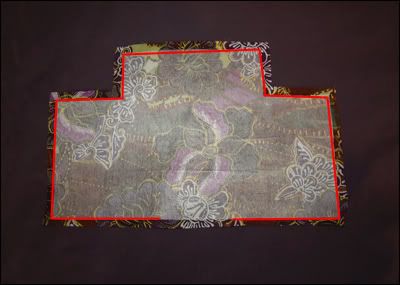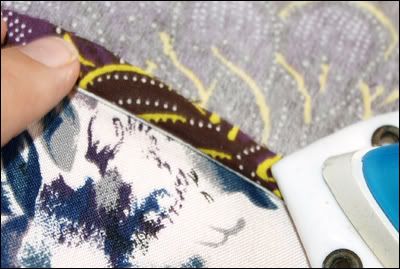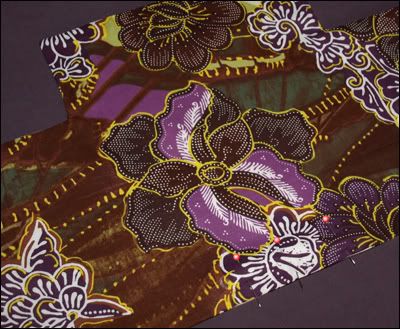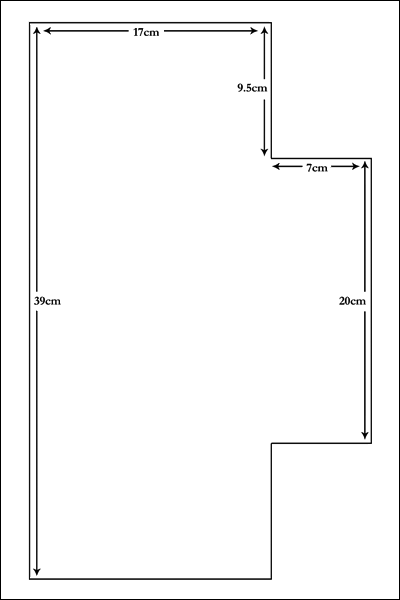Today did turn out to be productive after all! I finished as much work as I could on Dad's golf programme until he sends me more information, and I made chequebook covers for both EJ and his mum! And now here I am about to put together a tutorial for it. :)

Please note that this is a tutorial for Australian-style chequebooks. Australian chequebooks measure about 21.3cm x 7cm and open like a book, with the spine on the short side. I mention this because I originally got the idea for making these from crazy mom quilts' chequebook tutorial, but after making one I realised that our chequebooks must be different to American 'check'boooks, since her tut made a cover that was too short and opened along the wrong edge to slide in our chequebooks. So! Make sure to figure out what kind of cover you need to make before you begin.
Materials and tools

- Main fabric - stiff, non-stretch fabric; a good choice is upholstery fabric or denim, OR
- Main fabric + iron-on interfacing - if you're like me, you'll want to use a more spangly and less sturdy fabric, in which case you'll need to use some interfacing too. I'll be giving instructions for using interfacing.
- Lining fabric - same deal as your main fabric
- Cotton to match both main and lining fabric - you can just use one colour if you're not as nit-picky as me
- Pattern - you can either draw it (it's easy) or download mine below
Chequebook cover pattern
Click the image to download a zip package containing the image above as both a jpg and a psd file in the correct dimensions. The picture is meant to fit an A3 page, so you will need to print it over 2 A4 pages and stick them together.
Alternatively, get an old newspaper or catalogue and draw your own pattern according to the measurements indicated on the image above.
Method
1. Iron all your fabric. Trace the pattern onto your iron-on interfacing twice and cut out both. Place one piece of interfacing on your main fabric and one on the lining. Make sure that you place the interfacing at least 1cm away from the edge of your fabric and that you place it shiney side down. Iron it well, so that the interfacing doesn't peel up at the edges.

If you're not using interfacing, trace your pattern directly onto your main and lining fabrics using a fabric marker or taylors' chalk. Cut out leaving about 1cm seam allowance.
2. Once it is securely attached, cut out your pieces from the main fabric and lining, leaving about 1cm seam allowance. Place the main fabric to the lining, right sides together, pin and sew around the perimeter of your interfacing, leaving a space of 10 or 15cm in the middle of the long edge. Backstitch at the beginning and end of the seam to make it secure.

3. Trim the convex corners at 45 degrees, close to the seam. Trim the concave corners close to the seam as pictured, making sure not to trim too close or else the seam will split when you turn it.

4.Before turning, fold back the seam allowance and iron it flat. This will help to give you crisp edges and make it easier to close the hole. Once all seam allowances have been ironed open, turn the work right side out and use a skewer, knitting needle or something similar to help push out the corners and keep them sharp. (If you're finding the image below confusing, the blue patterned fabric is my ironing board.)

5. Once you're turned it right side out, iron it nice and flat and turn in the seam allowance around the hole you left for turning. Pin the hole shut, then sew a topstitch around the entire perimeter of the work as close to the edge as you can, closing the hole. This is where you should double check how you have your machine threaded if you're using two colours of cotton - make sure your bobbin is the colour of the side you have facing down while sewing, and the other colour on top.

6. Now fold over the two flaps, iron and pin them in place. There should be a gap of about 1cm between them in the middle, as pictured below. Sew an L-shaped seam (marked in red), then turn and go back over the same seam, keeping as close to the edges as you can. Cut and tie off your threads and you're done!

Congratulations! You are the proud owner of a personalised, funkadelic chequebook cover. Slide in the back cover of your chequebook and you're ready to go! Make them for friends and family - they're easy, quick and useful, and make a good gift for those who might be difficult to buy for (like my Dad). And you could definitely customise them more with appliques, embroidery, anything. :)


Good night all,
~Jessica







Thank you, thank you, thank you! I was just at that tutorial too and hunting all over, as apparently the Canadian banks emulate the Australian banks as far as chequebooks go.
ReplyDeleteNice post! Bank weigh styles are accessible in a limiteless show of outlines prints and examples. At present you're ready to add your own particular custom styles to checks or maybe make your own picture checks with altered check styles. Requesting online nowadays is a fun innovative journey.
ReplyDeleteCheck Ordering
Nice post! Every checkbook can match the person who buys it, with every team imprinted on the check helping to show off the inner fan of a person good enough to use a checkbook.
ReplyDeleteNFL Football Teams
Nice post! Most of the time the banks simply order the checks for you through other check printers and mark up the price even further. Now you will be able to order bank checks yourself directly online. Thanks.
ReplyDeleteFind your bank